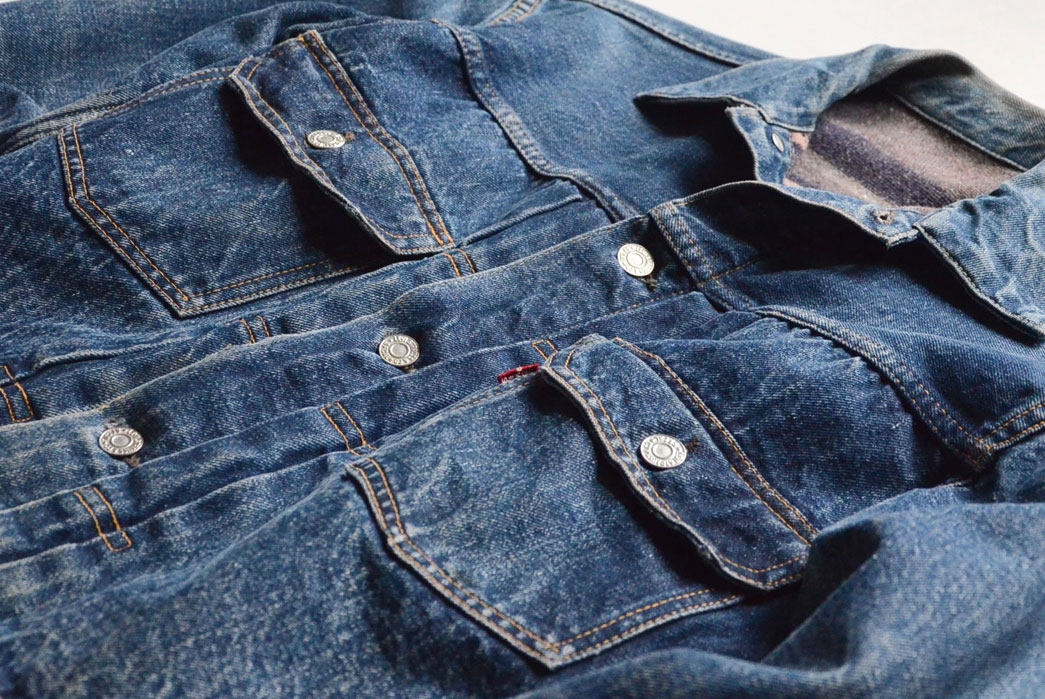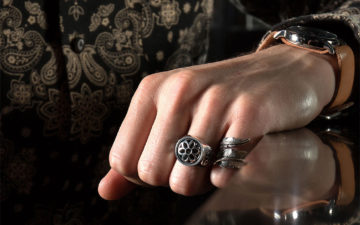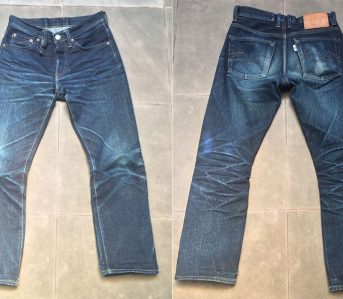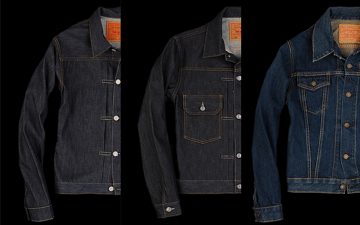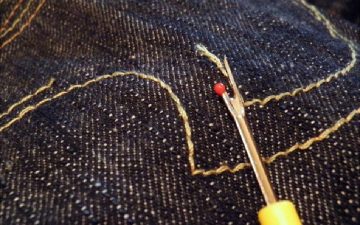It’s always with great care and respect that one speaks of a brand like Levi’s, a brand with such rich history and so many myths and legends attached to its name. The brand was founded by two European immigrants in America, Levi Strauss and Jacob Davis with their patent for copper-riveted jeans. The original use for the jeans was for miners during the Gold Rush–opportunists at the very bottom of the working class, venturing to California with very limited means, fighting the wilderness, each other, and deadly diseases eager to get a piece of the pie.
If Levi’s is known for one thing besides their jeans, it’s their jackets, which they’ve produced for over a hundred years. A century of truckers and blousons, however, has made for a multitude of models that many devote their lives to cataloging.

A young Mick Jagger, an anti-fashion icon sporting a Levi’s Type I. Image via LongJohn.
There’s no such thing as an official guide (i.e. provided by Levi’s) for dating vintage Levi’s jackets. Much of their original archives were destroyed in the San Francisco earthquake in 1906 and subsequent fire. One has to rely heavily on the knowledge of collectors and enthusiasts, communicating through cyberspace and sharing on various forums and blogs, their finds and findings. Sometimes incorrect, poorly written, badly translated or based on counterfeit products, these pieces of information are hard to trust, but that same uncertainty is what keeps the treasure hunt going, and what has kept it going for centuries now. It’s the existence of that grey area that allows collectors to transcend the academics, but we’re here to even the playing field.
Although an official guide would be convenient at times, it would also shatter some of the mystery attached to the Levi’s brand, as well as deprive us of the privilege of sharing the knowledge we’ve found. A heavily discussed topic already, this isn’t going to be the first, but we wanted to add to and improve the already available guides.
This article will help you sort and identify the types and dates of vintage Levi’s denim jackets from the three most iconic Levi’s designs:
- 506XX Blouse – later referred to as the first or Type I jacket (1905-1953)
- 507XX – also called Type II jacket (1953-1962)
- 557XX/Type III – referred to as the “Trucker” jacket (1962-present)
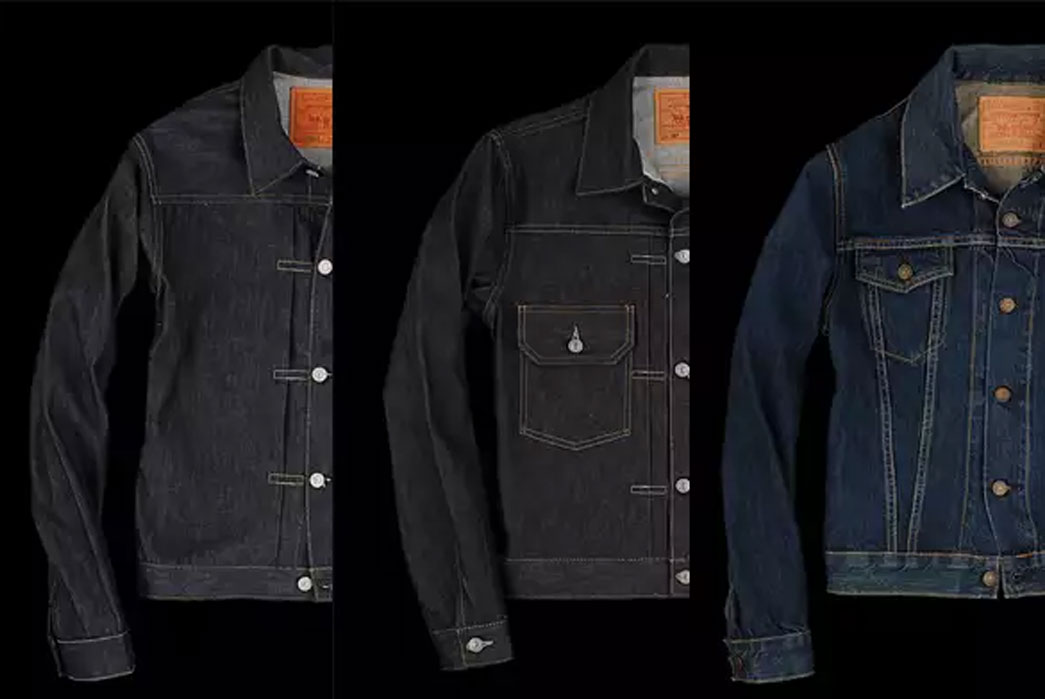
LVC reproductions of the three main designs: Type I, Type II and Type III.
The Type I and Type III have both run for more than five decades. Their designs have seen several changes over the years due to brand innovation, shift in trends, wartime, manufacturing costs/efficiency etc. Aside from the condition and design (a rare design is naturally more sought after) of the garment, age plays the biggest role in determining the worth of a vintage Levi’s jacket. Below is a list of features to take into consideration when dating vintage Levi’s jackets, beginning with the first things to look for.
Design: Type I, II, or III?
First off, start by determining the design of your jacket. Authentic Type I and II jackets are very sought after by collectors nowadays and commonly sell on the second market (e.g. eBay) for $1,000 – $6,000 US Dollars.
Should you be lucky enough dig out one of these from the attic of an older relative, there are ways to determine its production age and estimate its worth, but I’ll get back to that in a bit.
Type III (1962-present)
The most common design is the Levi’s Type III jacket, also referred to as the “Trucker” jacket. Introduced in 1962, it’s arguably the most popular design of them all, having been re-interpreted by numerous contemporary brands.
The general design has been in production for Levi’s for more than 50 years, and over years of big growth, taking Levi’s from an American national treasure to an international conglomerate. The jackets are produced in larger quantities and due to their age, less likely to be in rags.
The following questions and steps will help you determine the approximate age of any given vintage Type III:
1. Does it have side / hand warmer pockets?
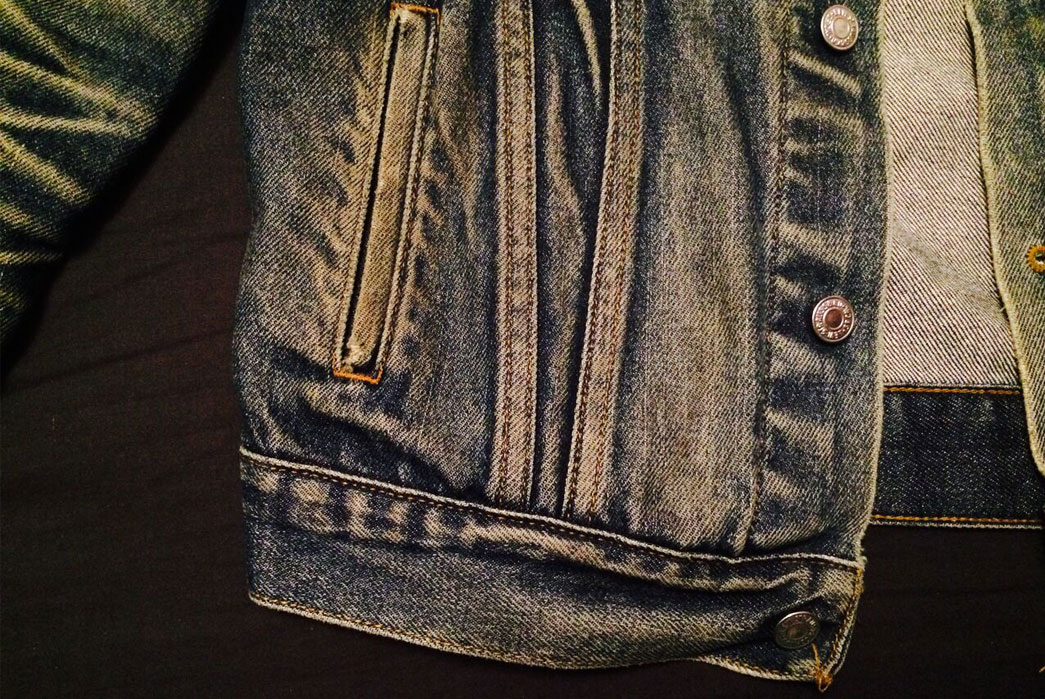
If your jacket has four pockets in addition to the two chest pockets, it’s been produced around 1984 or later. That year, Levi’s produced jackets and other clothes for the American team during the Olympics in LA.
Jackets with side pockets will not have a capital “E” on the Levi’s Red Tab, located on the left chest pocket. If it does it’s likely to be a fake. If it doesn’t have side pockets, it could be older than 1984 and you can proceed to step 2.
2. Does it have a capital “E” (referred to as “Big E”) on the Red Tab?
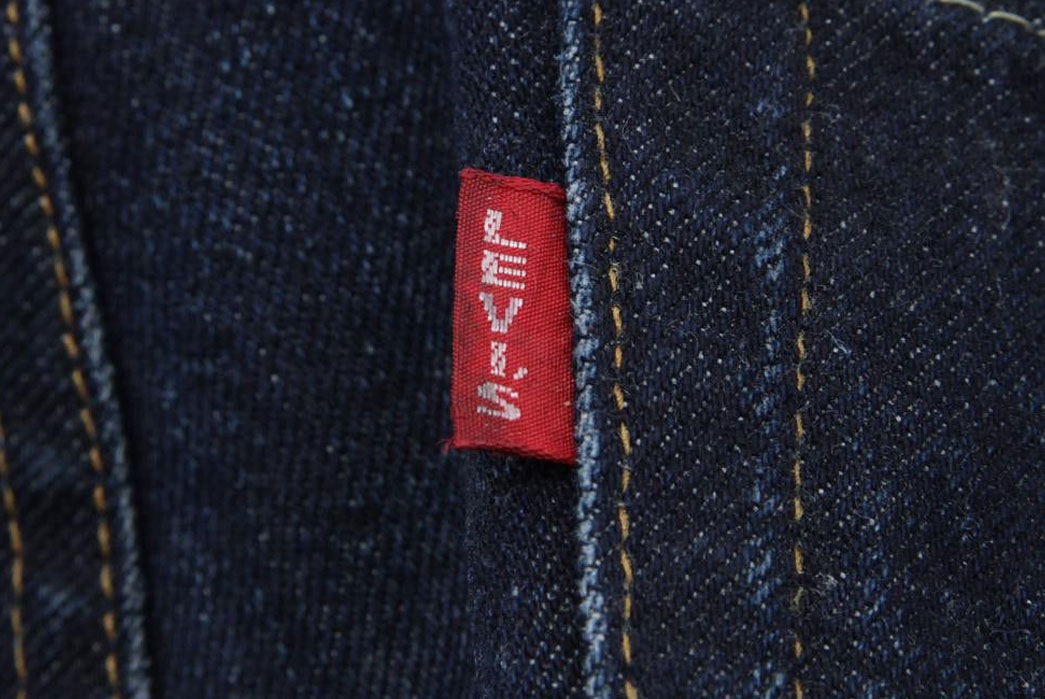
If yes, then your jacket is from 1971 or earlier. The Red Tab was introduced in 1936 as a mean of defending the Levi’s brand against copycats, mimicking features like the Arcuate on the back pocket of Levi’s jeans. The original Red Tab had “LEVI’S” in all capital letters on the front, no trademark and no writing on the back.
The design of The Red Tab was changed several times, with the trademark “R” and LEVI’S on both sides being introduced in 1950. But in 1971 the capital letters were changed so that only the “L” was capitalized. If your jacket has a small e-Red Tab and no side pockets, then your jacket was most likely produced between 1971-84.
If it has a Big E, then it’s starting to get interesting. These jackets are commonly found and are typically priced somewhere between $100 – $300 USD.
3. Does it have a care label?
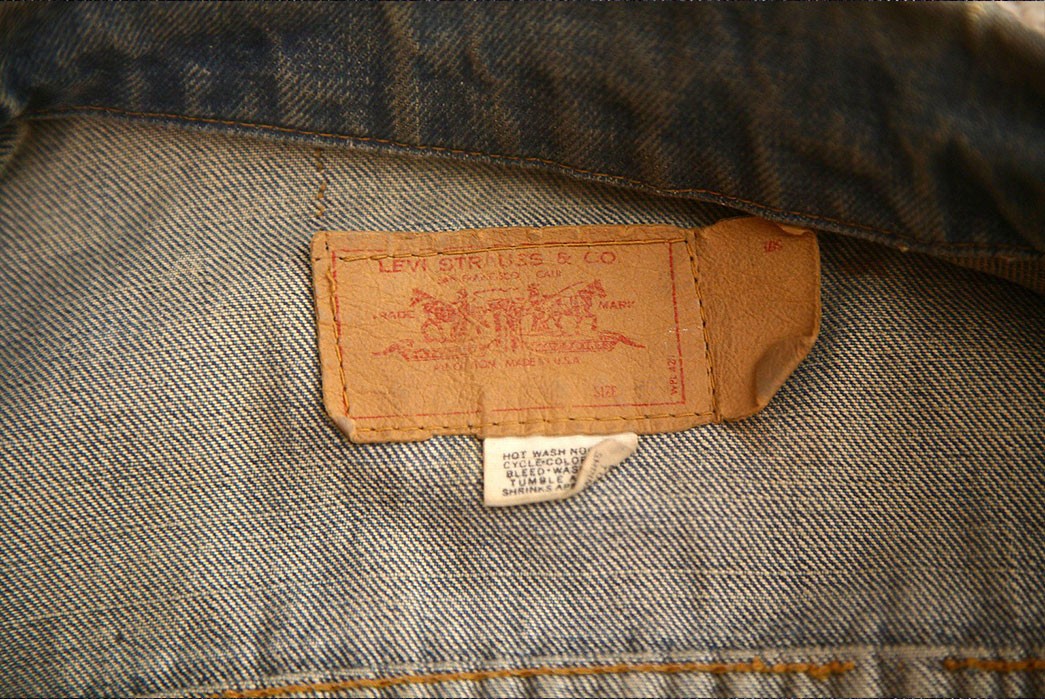
Image via We Are Koalas Vintage.
Care labels were introduced by law to USA-made garments in 1971, the same year as the Big E disappeared. Quoted from the official website of the Federal Trade Commission: “To assist consumers in getting information about clothing care, the Federal Trade Commission in 1971 issued the Care Labeling Rule.”
I’m unsure about the crossover between the design change of the Red Tab and the care label introduction, but I haven’t come across an authentic Big E with a care label before. If you have a Type I or II with a care label it’s definitely either a fake or a reproduction from LVC – Levi’s own reproduction line.
4. Does it have an intact Levi’s label in the back of the inside neck?
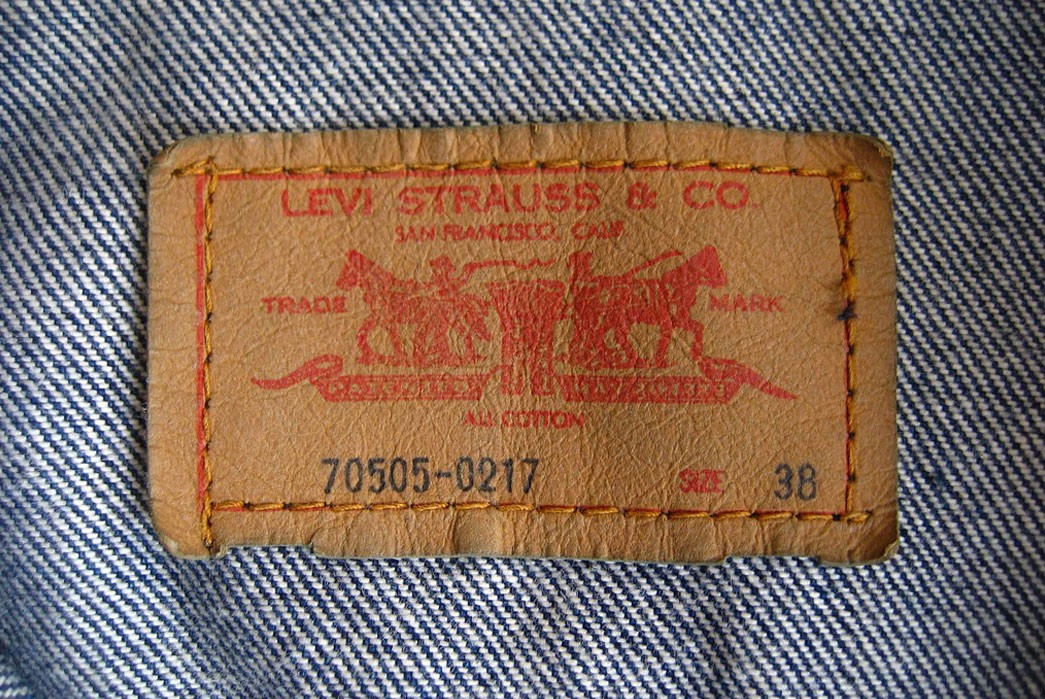
If yes, and the lot number is readable (lower left corner) you can check the lot number. If it’s tagged “557” followed by “XX” then it’s older than 1971 e.g. 70505 (slightly longer, introduced around ‘68). The Type III jacket evolved from the 557 series to the 70505, 71205, 70518 and so on, as different fits and lengths being introduced over time.
To my knowledge, there were only two issues of the 557 series, one in 1962 and one in 1967. Go to step 5 and learn the easiest way to separate early 557 from later issues.
5. Does it have lemon-colored yellow thread in the bar tacks under the pocket flaps?
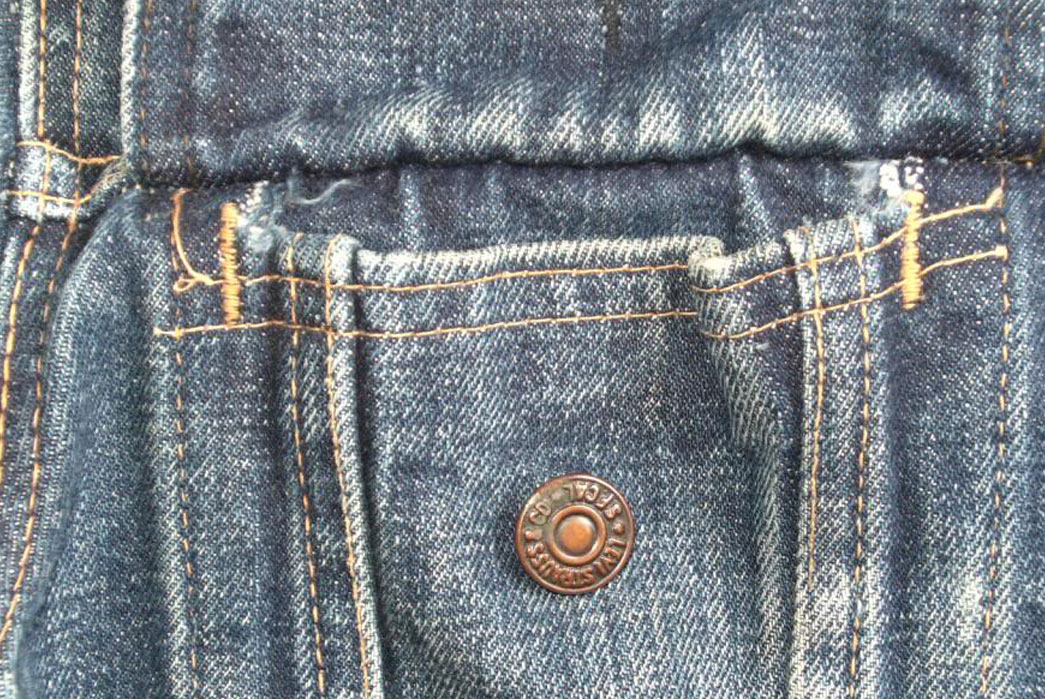
If yes, and your label reads “557” then you own an early version of the 557XX. The 70505 uses a navy blue/black thread color under its pocket flaps. Lemon yellow thread was phased out and replaced with orange thread as a main color, and around the late 60’s they stopped using it completely. Legend has it that Jacob Davis originally insisted that the thread should be orange to match the brand’s copper rivets.
Another sign indicating that you have a 557 and not a later issue is the size of the label. Even if the label has come off, which is the case with a lot of these jackets, you should still be able to see a mark from where the label was. The 557 label is bigger and not as rectangular as the 70505 and later labels. One exception is the crossover label of the “70505-0217”, in use from 1967-68. This is a very rare issue worth up to $500 USD.
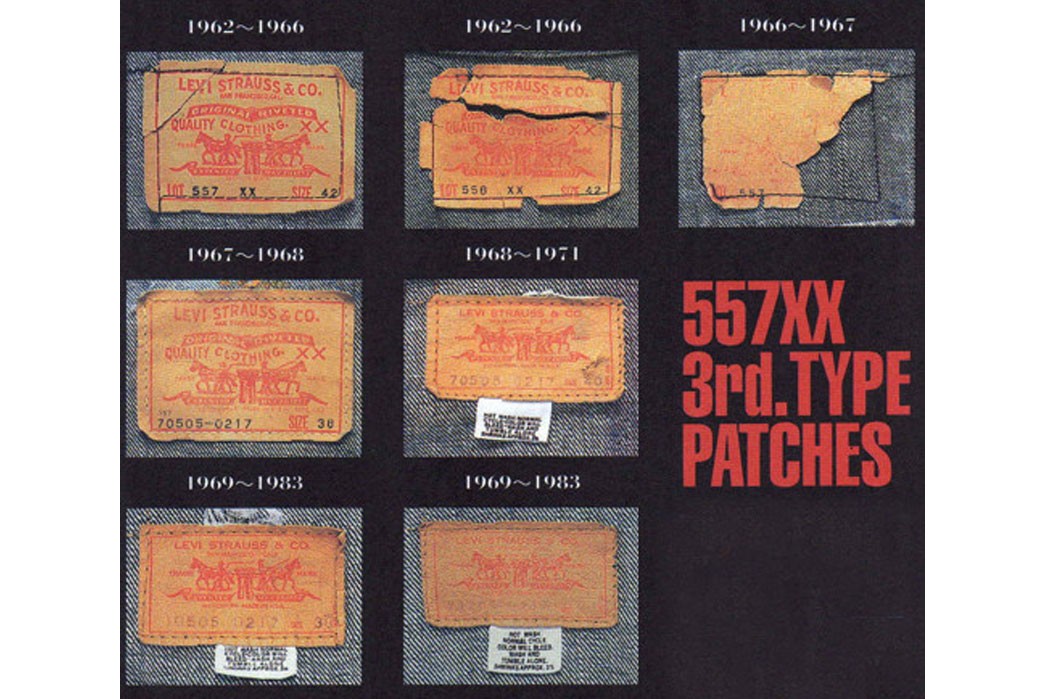
The evolution of 557XX, Type III jacket-patches. Notice how the label get’s smaller at the end of the 1960s, and notice the care label on the 70s labels. Image via Midwest Vintage.
6. Does it have a one-digit stamp on the backside of one or more buttons?
If yes, then it’s likely to be an early example. All jackets have a stamp on the backside of one or more of the buttons, and authentic vintage Levi’s jackets usually have one- or two-digit stamps as opposed to the three-digit stamps found on later examples.
Later stamps indicated the factory in which the item was produced. E.g. 555 indicates the Valencia St Factory, San Francisco which was in use from 1906-2002. Common 3 digit stampings are 524, 558, 555, 554, and are commonly found on LVC reproductions.
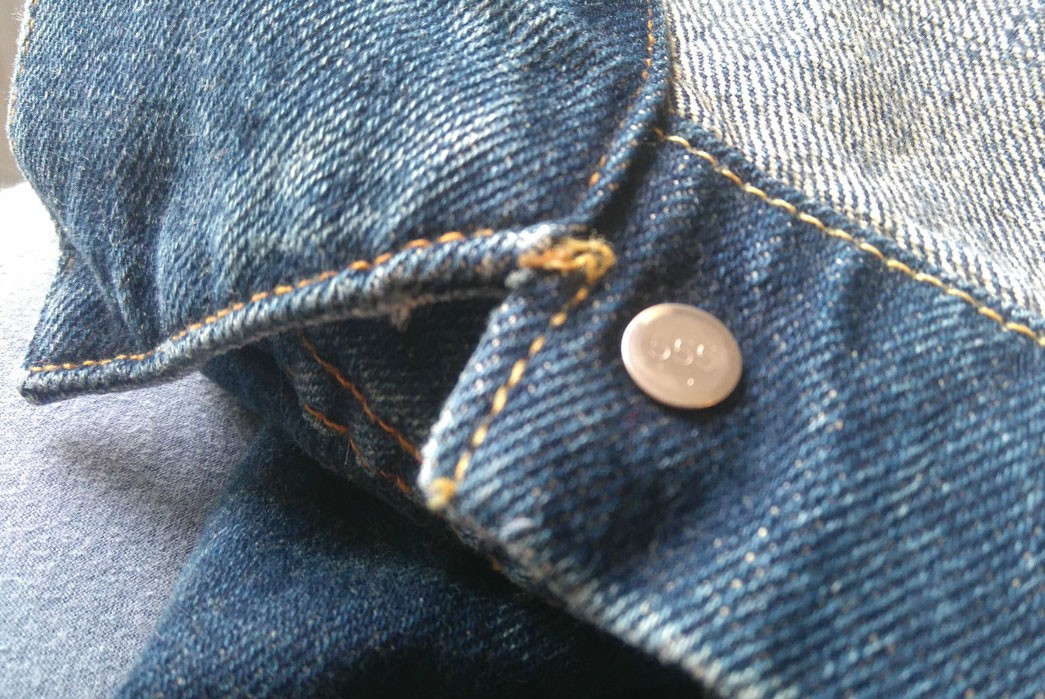
“555” stamp on a Type II LVC jacket. Image via eBay.
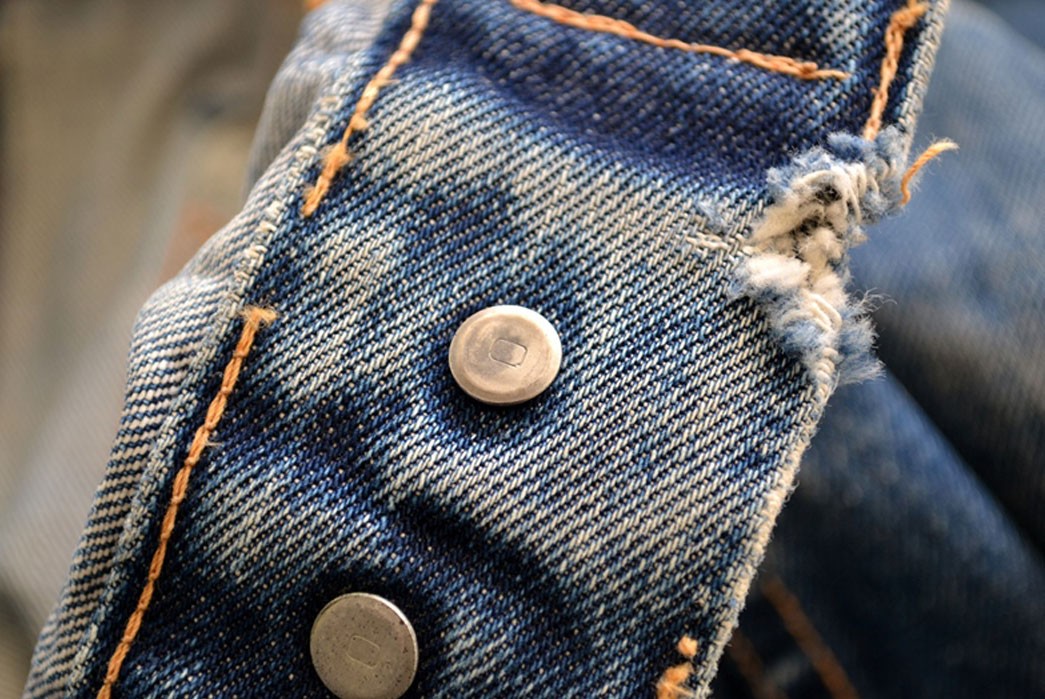
Notice the stamps “0”, indicating the authenticity of this early 60s Type III-jacket. Image via Long John.
With the above tools, you should be able to somewhat accurately date your jacket Type III jacket if not to the precise year, then at least get an idea of its worth and consequently bring it to a collector to look at. Many collectors can tell much more by touching and feeling the jacket and inspecting the denim for imperfections associated with vintage looms.
Other details like the thread (older thread being cotton, then replaced with poly-blend), rivets, etc. can also help hone in on a date, but that all gets slightly complicated to determine from photos.
Modern Type III Reproductions
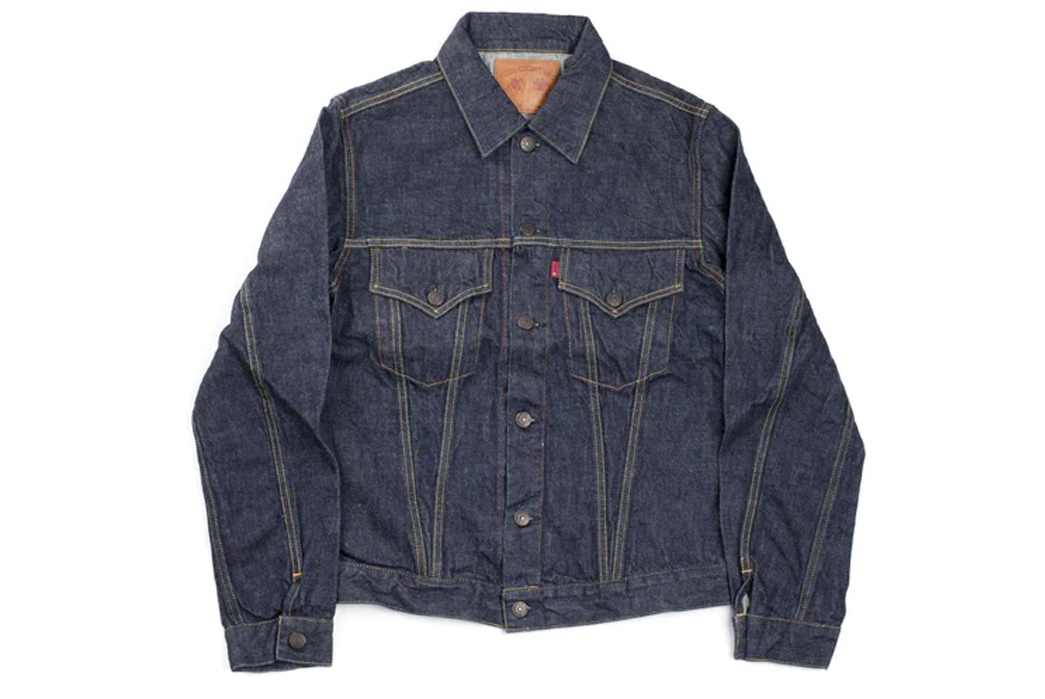
Full Count 2101 Type III Denim Jacket at Clutch Cafe.
Levi’s still produces the Type III, now listing it simply as a Trucker Jacket. There are also a plethora of Japanese brands reproducing various years and iterations of Levi’s design at a much cheaper price point and arguably higher quality than the genuine article. Check out offerings from:
- Boncoura
- Dawson Denim
- Full Count
- Iron Heart
- Japan Blue
- Oni
- Pure Blue Japan
- Samurai
- Sugar Cane
- The Flat Head
Type II Jacket (1953-1962)
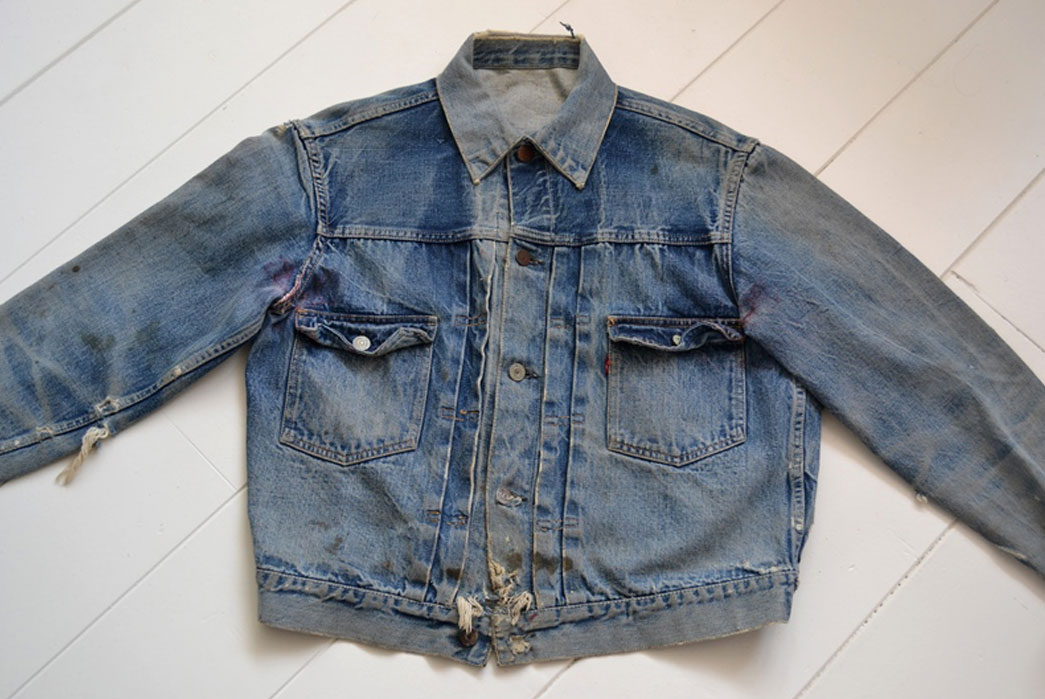
A killer vintage Type II jacket. Notice the short and boxy fit. Image via Long John.
Before the Type III, there was a style called 507XX, also known as the Type II. If you have an authentic Type II jacket it’ll bring in between $800 – $1,500 USD on eBay. General characteristics include:
- Two chest pockets
- Pocket flaps
- Selvedge inside placket
- Knife pleats
- Bar tacks instead of rivets, on pockets under flaps
- Rivets on cuff vents
- Leather label (first editions, then replaced by press card)
- Iron buttons (silver color)
- Back waist tabs, no cinch-back
The design of the Type II didn’t vary significantly throughout the course of its issue. The closest marker of its date is the patch label.
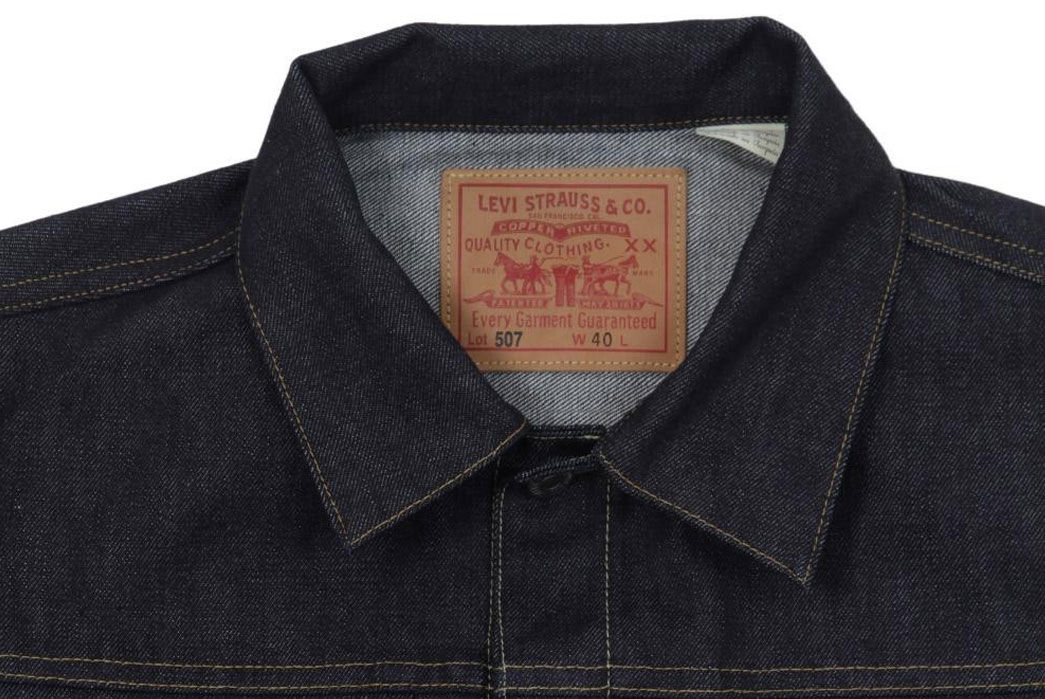
Leather label on a Levi’s Vintage Clothing repro 1953 Type II denim jacket. Image via End.
If the label remains, and it’s made of leather then your jacket is an early issue of the Type II jacket. Sometime in the 50s these leather labels were replaced with press card labels as found on the later Type III jackets. If you have a leather label issue it’s older and worth more money.
Look out for fakes or reproductions sold as vintage!
An authentic vintage Type II jacket should feature:
- Red Tab should have a trademark “R” and writing on both sides
- The main thread color should be lemon yellow.
- One- or two-digit stamp on the backside of buttons*
- Authentic wear to the denim
- Selvedge inside front placket (and only there!)
- Fit should be short and boxy (not modern)
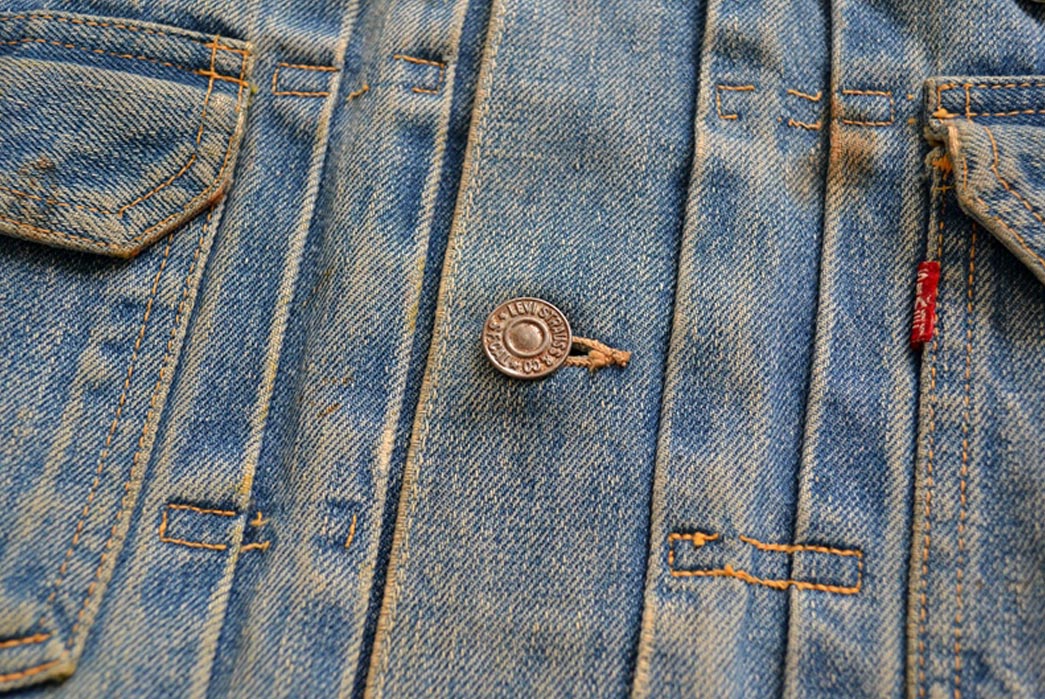
Customized Type II jacket. Notice the writing on both sides of the Red Tab. Image via Long John.
*If it has a three-digit stamp on the inside of a button, e.g. “555”, the jacket is an LVC reproduction and should be sold as such. These are still nice jackets, but they’re no collector’s pieces.
Modern Type II Reproductions
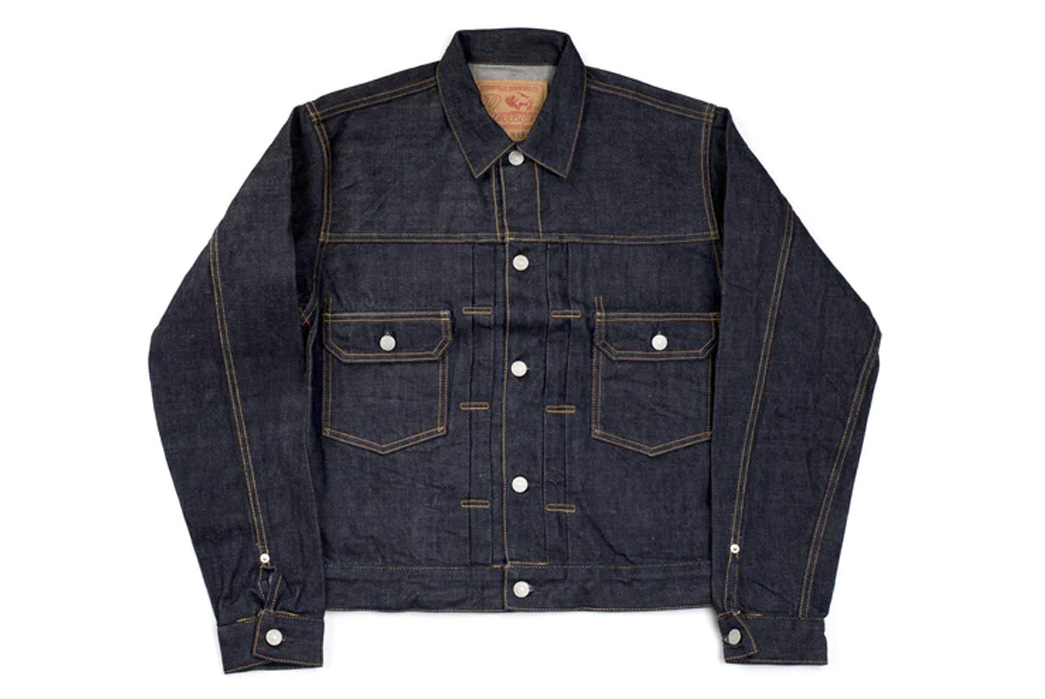
Pherrow’s 407J Type II Denim Jacket at Clutch Cafe.
Levi’s stopped production on the Type II in the 1960s and stopped production on their own licensed reproduction just a few seasons ago. But like the Type III, numerous Japanese reproduction houses still make the iconic style to the stitch, including:
Type I Jacket (1905-1952)

Image via eBay.
Levi’s introduced the 506XX Blouse or Type I to the market in 1905 as the first jacket in the XX-range. There are many speculations on what “XX” actually denotes, including the meaning unsanforized or hidden rivets, so I wanted to clear this up for the people in doubt with a quote from Levi’s own website:
“In 1873, Levi Strauss and Jacob Davis first introduced their classic blue jean. However, by 1890 their exclusive patent for riveted clothing had expired, meaning that other companies could use the same construction. In response to this impending competition, Levi Strauss & Co. printed the inside pocket bag with information about the garment’s originality and extra strong denim — referred to as “XX” (…) Made with XX denim from the Amoskeag Manufacturing Company, the 501® Jean remained at the head of the class and set a new standard for American workwear.”
The 506XX blouse was referred to as number one from 1917 onwards, and the name was changed from “blouse” to “jacket” in their 1938 Western catalog, Dude Ranch Duds. Levi’s made a total of 6 versions of this jacket, dated respectively:
- 1905 – Original issue
- 1928 – Pocket flap introduced
- 1936 – Red Tab introduced, but without “R” and “LEVIS” only on one side
- 1941 – Pocket flap removed during WWII, donut buttons introduced etc.
- 1944 – Cinch-back slider introduced
- 1947 – Pocket flap reintroduced
If you are in the unlikely situation that you own one of the above-mentioned jackets, then it’s worth a lot of money. When it comes to price though, age is not always the most important factor. Rare, unusual issues, like those from WWII are sometimes higher priced than those from the 1930s. But regardless of its exact age, if these characteristics sum up your jacket, I’d suggest you take it to a vintage expert to have it appraised.
The placement of the pleats and the shape of the pocket flap changed over the years, amongst other things like the fit. General characteristics include:
- One left chest pocket
- Riveted pockets and cuff vents
- Knife pleats
- Selvedge detail inside the front placket
- Cinch back / buckle back at lower center back as opposed to waist tab buttons on the Type II & III
If these characteristics sum up your jacket, then I’d suggest you take it to a vintage expert to have estimated and looked at, it’s most likely worth over $1,000. But below are some questions to help you further determine the date of your jacket.
1. Does it have a bronze cinch back slider?
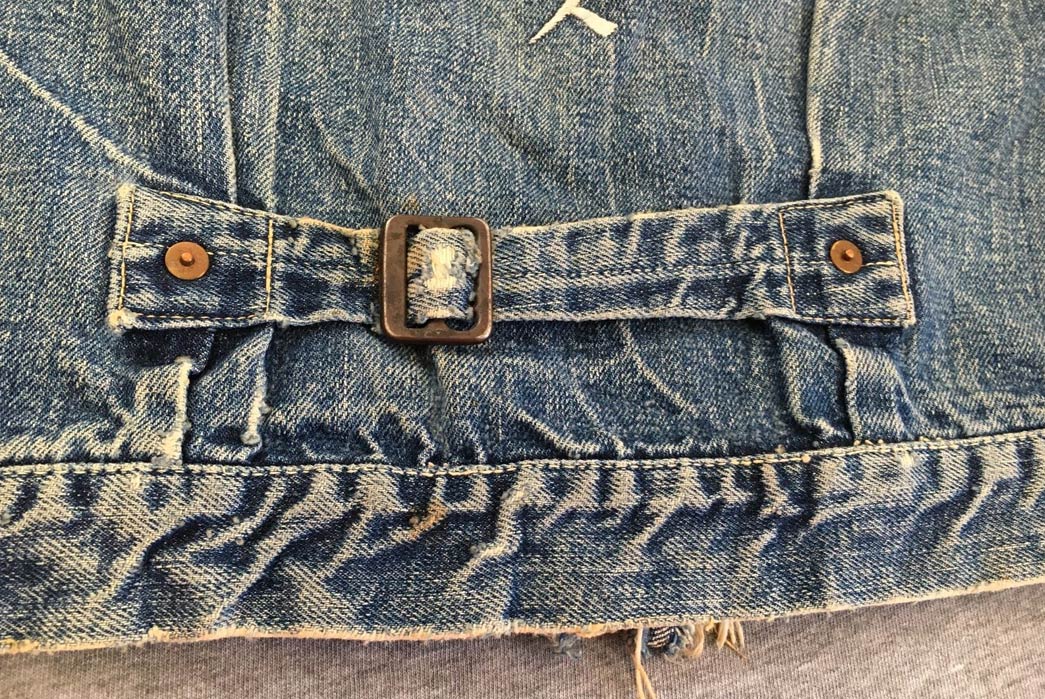
Bronze slider cinch-back on late 40s Levi’s jacket. Image via eBay.
If your jacket has a bronze cinch back slider, as opposed to a silver one (early silver ones had pin teeth instead), then it’s later than the 1944 issue when metal was being rationed by the US government due to WWII. The bronze slider buckles were also used after the war ended, until the cinch back was replaced with waist tab adjuster buttons on the Type II pattern in 1953. If it has a silver buckle (slider or pin teeth) instead, then skip to step 4.
2. Does it have a pocket flap?
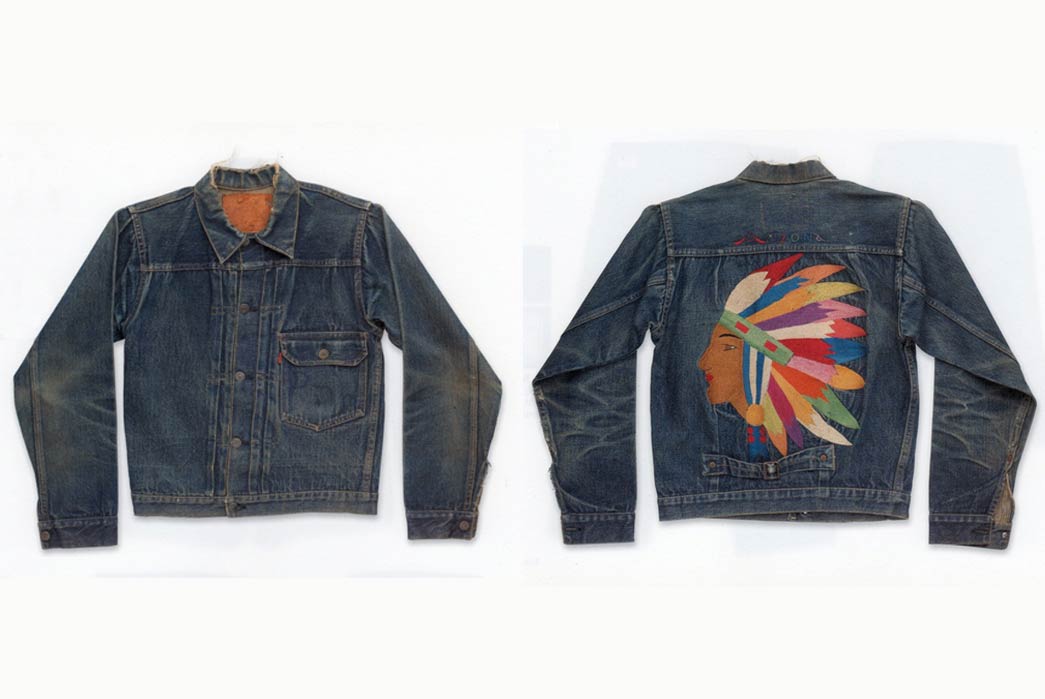
1947 issue of a Levi’s 506XX (Type I) jacket with an Indian embroidery on the back. Slider back buckle, Levi’s buttons as we know them from today and patina-ed fades.
If your jacket has a pocket flap and a bronze cinch back slider, then it’s likely to be from the late 1940s (possibly 1947) when the war was over, and the pocket flap reintroduced along with the bronze cinch back slider. This was the last issue of the Type I jacket.
3. Does it have silver-colored (iron) donut buttons?
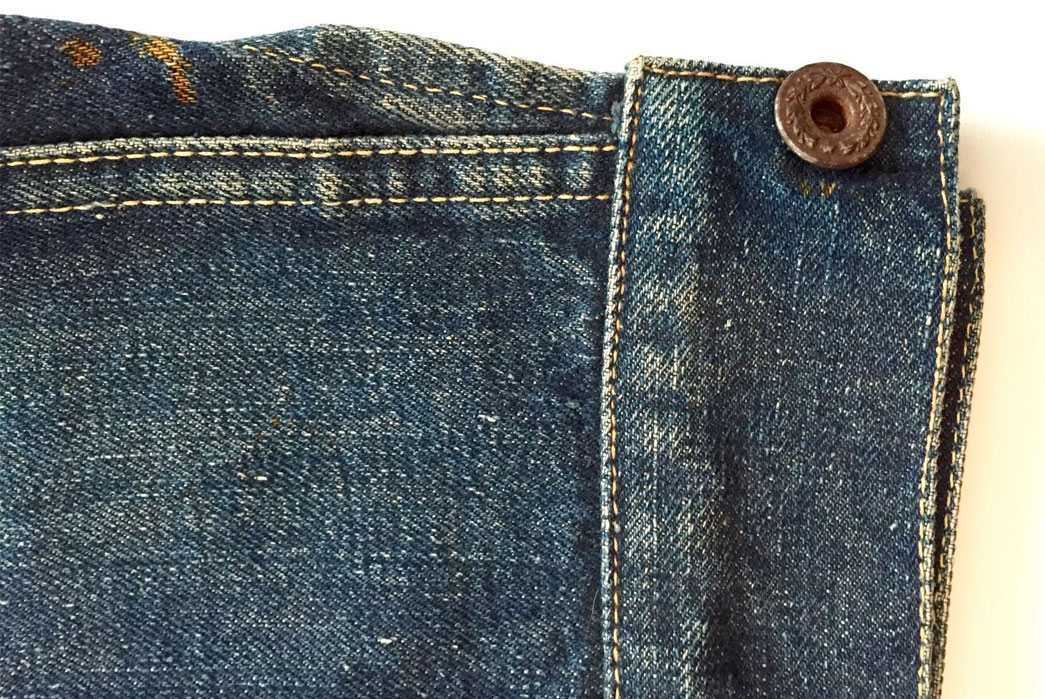
Laurel leaf-donut button on a WWII-issue of a Levi’s 506XX (Type I) Jacket. Image via eBay.
When American manufacturers rationed metal for WWII, casting a button with a hole in the middle (referred to as a “donut button“) used significantly less material. Some donut buttons were adorned with a laurel leaf design which is a symbol of peace and triumph of the human spirit, some were stamped with signature Levi’s, and some were bare.
4. Does it have a silver slider with pin teeth?
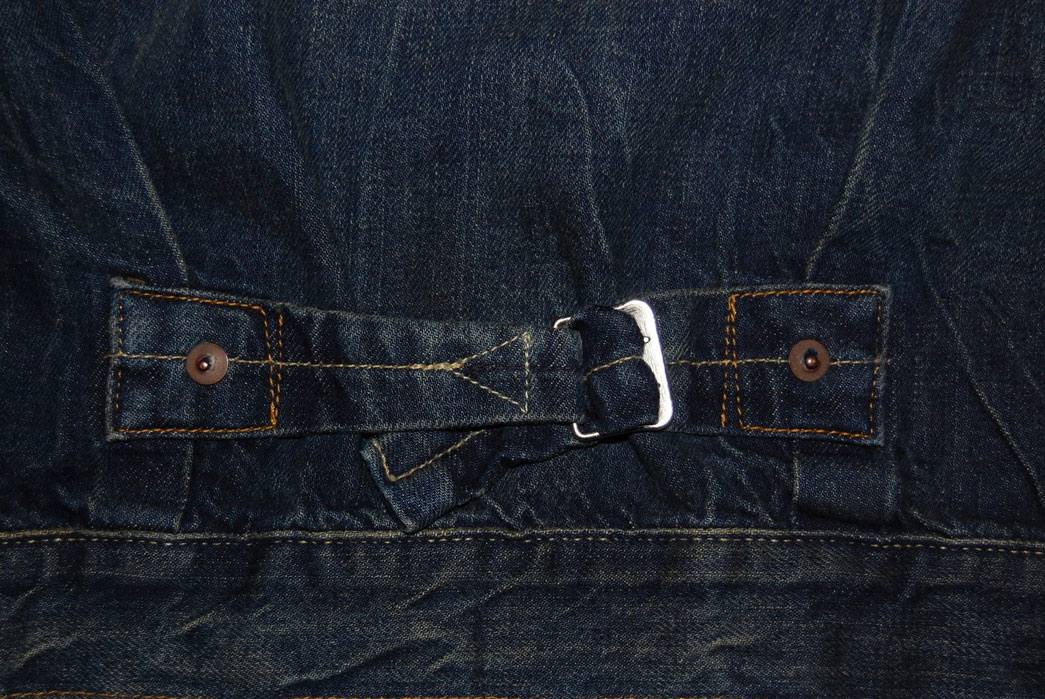
LVC 1936 Type I repro jacket back cinch. Image via A Suit of Tools.
If your jacket has a silver slider with pin teeth, and the features from steps 1, 2 and 3 – then your jacket is very likely the 1941 issue. If not, it’s from 1936 or earlier.
5. Does it have a pocket flap, silver pin teeth cinch-back and standard Levi’s buttons?
If your jacket has a pocket flap, silver pin teeth cinch-back and standard Levi’s-stamped buttons (as we know them from today), then your jacket is from 1936 or earlier.
6. Does it have a Levi’s Red Tab?
As previously mentioned, the Red Tab was introduced in 1936 to combat copyright issues. The 1936 issue of the 506XX, Type I jacket, was the first with a Red Tab. So if you have a tab and the features mentioned in step 5, then you probably own a 1936 issue. If there isn’t a Red Tab (check if it’s maybe fallen off), you might have an even rarer issue from 1928.
7. Does it have a slightly lower placed left pocket with no pocket flap and no signs of a Red Tab (and does it look extremely old and battered)?
If this is the case, then you might be the lucky owner of the first issue of the infamous 506XX Blouse. According to Levi’s Guide, buttons from 1902-1928 were black donut buttons stamped with “Levi Strauss & Co.” and no country of origin (S.F. Cal.)
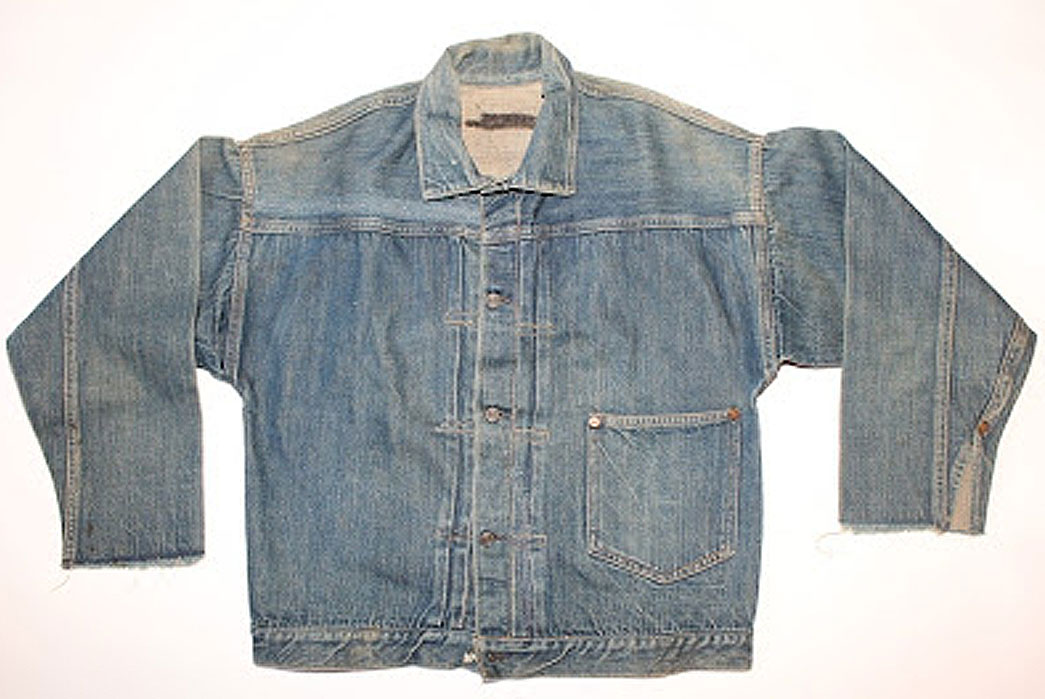
The closest thing I could find to a 1905 issue of the Levi’s 506XX Blouse. Image via Google.
Bear in mind that Levi’s did introduce another and slightly cheaper line of jackets, called Lot 213, that didn’t make use of the signature XX-denim. They had a very similar design and are also highly sought after by collectors.
For example, last year a 20s-30s version was sold on eBay for $3,000 USD. Without the label present, it would be hard to tell these jackets apart without being able to feel the weight of the denim in real life.
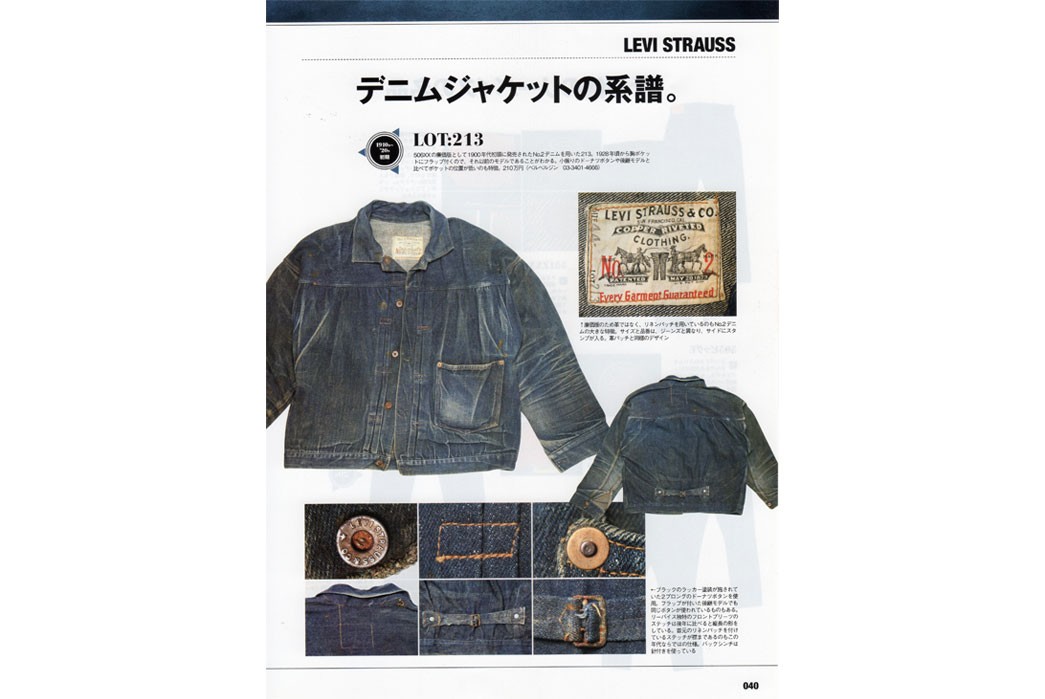
Excerpt from a Japanese book on Levi’s, here showing an example of the Lot 213-line. Image via Pinterest.
Modern Type I Reproductions
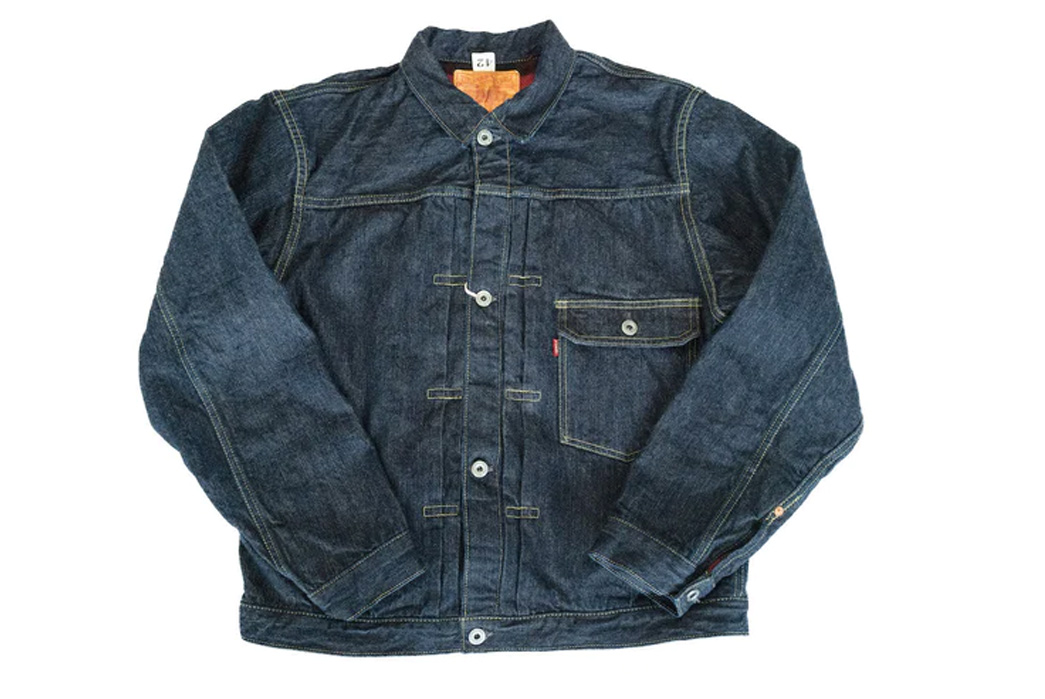
If you’ve come this far then you’re either the lucky owner of a museum piece of clothing, or you’re just really interested in the questionable historical facts found on the internet surrounding Levi’s and their origins.
Regardless of your motives, if you know more than I do, please comment away, and we will be happy to include you and your knowledge in the post to get the most accurate descriptions of the jackets.
As mentioned in the introductions, a lot of these facts are based on other collector’s findings and translated from other languages. These sources base their knowledge on their respective research and are not approved by Levi’s themselves. However, we hope they are helpful in your search.


